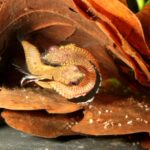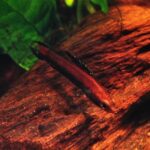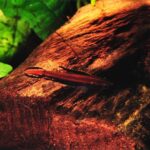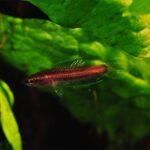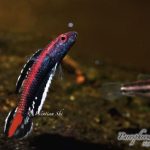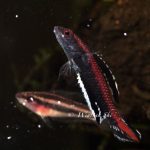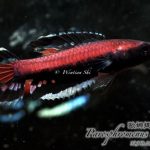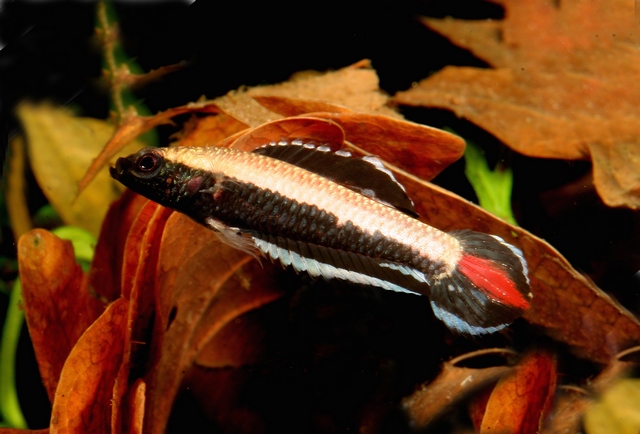
Kottelat 1991
First description: Notes on the taxonomy and distribution of some Western Indonesian freshwater fishes, with diagnoses of a new genus and six new species (Pisces: Cyprinidae, Belontiidae, and Chaudhuriidae). Ichthyological Exploration of Freshwaters, 2: 273-287.
Characteristics: total length max. 3.5 cm. Dorsal structure: IX-XI, 6-7, total 16-17, anal fin: VII-IX, 10-13, total 18-21. Much leaner, with a less high back compared to the other species, with the exception of P.parvulus. Adults appear to have a wide oval cross-section, seen from the front. It differs also in behaviour and coloration. The ♂ shows characteristic, nagyi-like body coloration in breeding colours: lower half of the body very dark to black, upper half red-brown. The patterns of the unpaired fins differ from the typical ones in this species: dorsal and anal fin are black with white spots and relatively broad and very luminous white iridescent edges. The ventral fins are transparent, the caudal fins have a characteristic, peculiar red flame pattern. It is striking that this colouration is visible almost at any time; the species-typical striped patterns can be seen rarely in sexually mature males (only during extreme stress). The female shows the striped patterns normally , but during courtship the dress is almost identical with that of the male, including the red flames of the caudal fin. In this situation it is possible – considering only the colours – to confuse the sexes, but the behaviour (see below) allows clear identification of gender.
Similar species: There is no risk of confusion between males of other species. The structurally similar species parvulus can be distinguished clearly by coloration and pattern. Only the females can easily be confused with parvulus in normal colouration and small fry of both species are almost indistinguishable.
Occurrence / Distribution: Western Borneo, Kalimantan Barat, Catchment of the Kapuas river, between Sungai Penjuh and Anjungan, north west of the city of Pontianak. Linke describes a habitat (pH 4.5, conductivity 39 micro-Siemens, temperature 27.6 degrees C), in which this species co-exists (in different ecological niches) with another licorice gourami species, P. anjunganensis. Only very few cases of syntopic occurrence of licorice gouramis are known and – very obvious in this case – the difference of both symbionts plays an important role. H. Kishi (Team Borneo, private message 2011) confirms this use of a common habitat for the Sungai Kepayang close to Anjungan. However it is not a true symbiosis, but the use of different niches in a common habitat.
Threat: although P. ornaticauda appears today occasionally in high numbers in the international trade, and although significantly more locations are known compared to the time of its discovery, it has to be accepted that the species is highly endangered. Part of the original habitat is already destroyed and has been transformed to palm oil plantations. Many of the still existing P.ornaticauda-biotopes have been badly damaged by contamination with pesticides. Mainly these habitats are more or less affected remnants of swamps, still holding black water, but these refuges are getting smaller and smaller.
Discovery/First import:found by Kottelat in 1990. Because of its uniqueness, the first description was quickly made one year later. In 1990 the species was brought to Europe by Bauer, Neugebauer and Linke.
Trade: To start with, the species was seldom traded; now several thousands of each year´s juveniles are brought to the international ornamental fish trade, where they usually die in large numbers due to their low resistance to bacteria. Because this species belongs to the more difficult forms of licorice gouramis, most of the fish lead a short life as an “exotic aquarium speciality”. Many of the fish seem to be already harmed by toxic emissions in their natural habitats as juveniles so that they are already ill when they reach the traders. In this case they quickly die from getting weakening parasites like velvet (oodinum), either in the tank, or earlier,in one of the various trading stations.
Care / Breeding: regarding care and maintenance, this species differs little from other licorice gouramis, but it might live even more secretly than others and stay hidden. It is not a beginner´s fish. P. ornaticauda still poses many problems regarding breeding. There are only few cases in which breeding was easy and successful; many more cases are exactly the opposite. The clutches are usually small (10 to 20 eggs, rarely more) and they are often “rearranged” (from one cave to another) or “disappear” completely over night. The courtship dance of the male (see below) needs a lot of space, so small tanks (around 10l) are less suited then tanks with 20l or more. The conductivity of the water should not be above 40 micro-Siemens. The sensitivity of the eggs towards harmful bacteria is high, so it is advisable to have a low pH value (between 3 and 4) and a high content of humic acids. However, successful breeding has been recorded at pH 6.5 in clear water. Still, successful ornaticauda breeding is regarded as the “high school” of licorice gourami hobby.
Behaviour / Particularities: Head-up courtship. Standard cave breeder with high adaptability of the preferred breeding sites (ranging from fully closed caves to broods under leaves or under open floating spawning rafts). Many of the fish prefer very narrow spawning caves (diameter of the entrance 1.5cm) in different positions within their area of activity. This area is larger compared to other licorice gouramis, because the male – similar to parvulus – carries out a spectacular courtship dance, in which it first presents its strikingly iridescent fin edges and then jumps around the female in very fast zig-zag movements. Another particularity – differing from parvulus this time – is that the females take on a colouring during courtship that resembles the nuptial pattern of the male, even including the red flames in the caudal fin. This colour change is unique among all members of Parosphromenus . This behavioural characteristics justify a special position of the two lean forms throughout the genus, which have not sufficiently been considered in the recent systematic – a systematic which does not consider ethological aspects. Eventually these particularities might justify the establishment of a new sub-genus.
Literature:
Weblinks:
PF / HK


